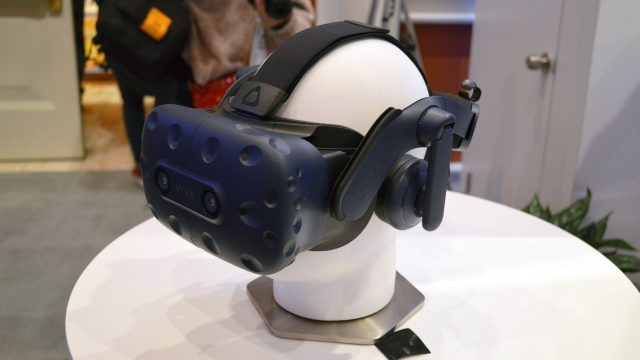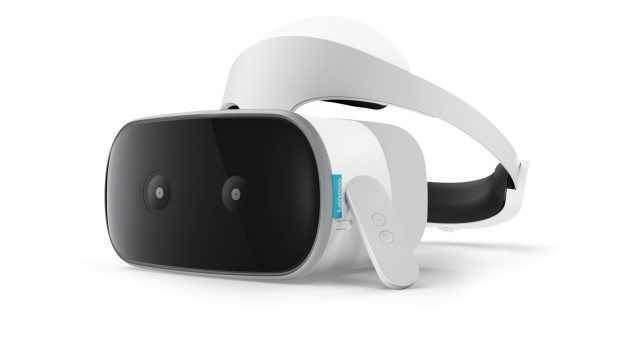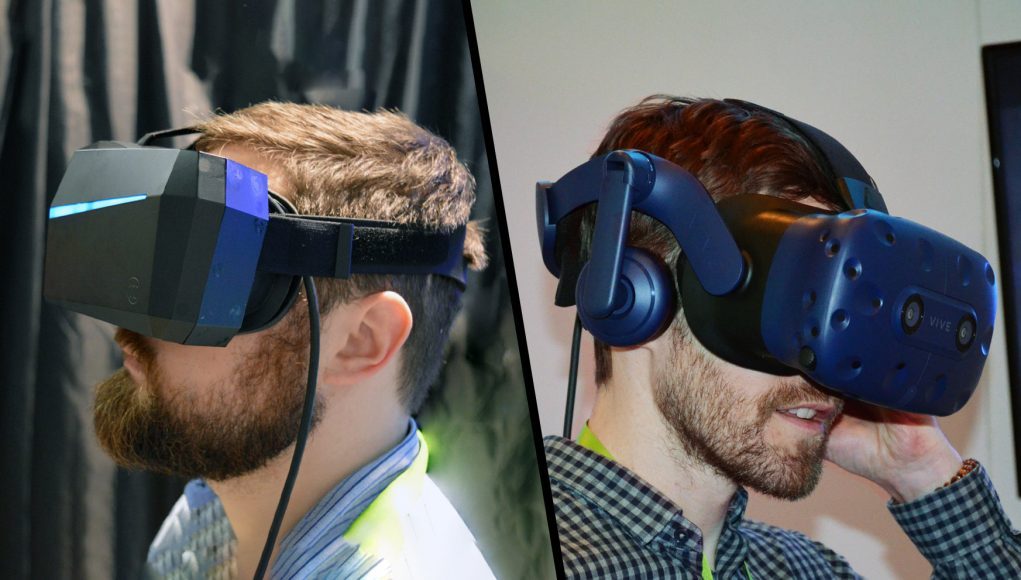CES 2018 has come and gone, and with it, a pace has been set for what we can expect to see in VR in the next six months or so. If you weren’t following the day-to-day news, here’s a look at the top stories and what they mean going forward.
HTC Vive Pro

Perhaps the biggest reveal at CES 2018 was HTC’s Vive Pro. The new VR headset is essentially a complete redesign, notably with an improved screen (upgraded to 2,880 × 1,600 from 2,160 × 1,200), but a number of other enhancements as well. Check out our hands-on for a breakdown of everything the headset has to offer.
Set to be offered initially as a headset-only upgrade to existing Vive users in Q1, a complete package offering new controllers and base stations compatible with SteamVR Tracking 2.0 will be launched later in the year. The Vive Pro and original Vive are planned to be sold alongside one another. As a side note, HTC confirmed to us that the Vive Pro won’t ship with Valve’s ‘Knuckles’ controllers, a bummer for those hoping to finally get their hands on the anticipated controllers which were first revealed back in mid-2017.
HTC also announced an official, optional Vive Wireless Adapter which is planned for availability in Q3 with support for both the Vive Pro and the original Vive. See our hands-on here.
Pricing for the Vive Pro and Vive Wireless Adapter hasn’t yet been announced.
What It Means
The lack of pricing information leaves a big question mark over the impact that the Vive Pro and Vive Wireless Adapter will have in 2018.
The Vive Pro is a clear upgrade over the original Vive, with greater comfort and better visuals. Undoubtedly it stands to put pressure on Oculus who have suggested on a number of occasions that they don’t plan to release a successor to the Rift in 2018. While the Rift debuted back in 2016 with many of the conveniences that now come default with the Vive Pro (notably the rigid head strap with built-in audio), the Pro now has an unignorable lead in visual clarity thanks to its higher resolution screen.
My best guess is that the complete Vive Pro system (headset, base stations, and controllers) will debut at the $800 price point that the Vive had originally launched with back in 2016. If that’s the case, the headset may be in a difference price class entirely compared to the $400 Rift, which means the Rift would still be primarily competing against the Vive rather than the Vive Pro.
But when it comes to commercial and enterprise usage, the Vive Pro (assuming an $800 price point) now appears the obvious choice, especially thanks to SteamVR Tracking 2.0 which can track up to 33 × 33 feet volumes with four base stations. In these sectors, HTC is already believed to have a strong lead over Oculus, and the Vive Pro could cement that throughout 2018.
The big question is whether or not Oculus will introduce their own ‘Rift 1.5’ with an upgraded resolution to match the Vive Pro. With the original Rift and Vive believed to the using the same Samsung-made OLED displays, it seems likely that the new displays being used in the Vive Pro (also believed to be from Samsung) could be installed into the Rift without a major redesign, but, without a better understanding of the internals of the Vive Pro, it’s hard to say.
Lenovo Mirage Solo

At CES 2018, Lenovo debuted the first of the Google-inspired standalone VR headsets based on the Daydream ecosystem, the Mirage Solo. As a standalone headset, the Mirage Solo has everything built inside for a VR experience (display, battery, processing, etc), which means it doesn’t rely on a snap-in smartphone or external computer/console.
It’s also the first Daydream headset to debut with inside-out positional tracking (6DOF), though the controller retains only 3DOF (rotational tracking).
The Mirage Solo is set to hit shelves in Q2, though Lenovo is being cagey about the price. The company says it’ll be priced “under $400;” and while we’d usually assume they just mean $399, they told us “We’re working on driving down the price so that it’s accessible to more people, and we believe we can reach a more mainstream price point than the prices we shared.”
What It Means
From a performance standpoint, the Mirage Solo is definitely an upgrade over pretty much every mobile VR headset currently on the market. The addition of 6DOF tracking makes for a much better experience which feels much closer to high-end VR headset. There’s also a lot of advantages that come with a standalone design, like improved battery life (which isn’t shared with your smartphone), potential for much better thermal design (resulting in greater performance with less overheating), and more.
However, with the controller having only 3DOF (rotation only) tracking, input is going to be a bit awkward and limiting compared to what would be possible with a fully 6DOF standalone like Oculus’ Santa Cruz prototype which we saw late last year. It’s also unclear how many developers will develop games and experience which take full advantage of 6DOF tracking when the vast majority of mobile headsets currently in existence are only 3DOF. The 6DOF/3DOF split could create undesirable capability fragmentation, at least until the bulk of mobile VR headsets have 6DOF (which they hopefully will sooner rather than later).
Another major question is the price of the Mirage Solo and what it will mean for traction. Mobile VR is all about ‘causal’ and ‘convenient’, but $400 (or even $350) is a significant purchase for a dedicated gaming device. When serious gamers can pick up a 1TB Xbox One or PS4 for $280, the question must be asked—exactly what kind of casual gamer will be dropping $400 on a VR headset? And if they aren’t casual, they probably already own a PS4 or modern gaming PC, which means for about the same price they could easily nab a Rift or PSVR.
Oculus, on the other hand, plans to debut their standalone ‘Go’ headset soon with a much more ‘casual’ $200 price point. And while means the exclusion of 6DOF tracking, it may make more sense for the casual VR niche than a $400 headset like the Mirage Solo which has more features but still fundamentally provides a mobile VR experience.







